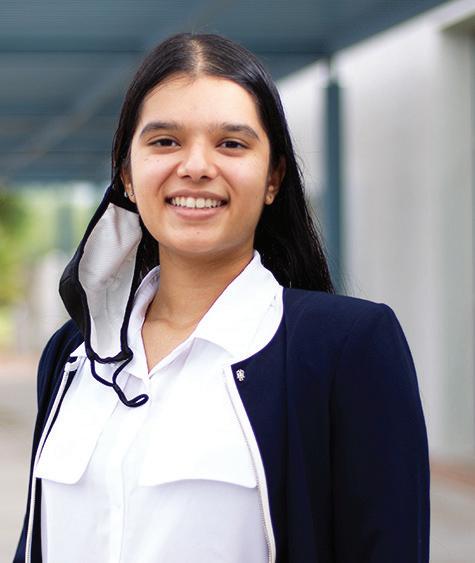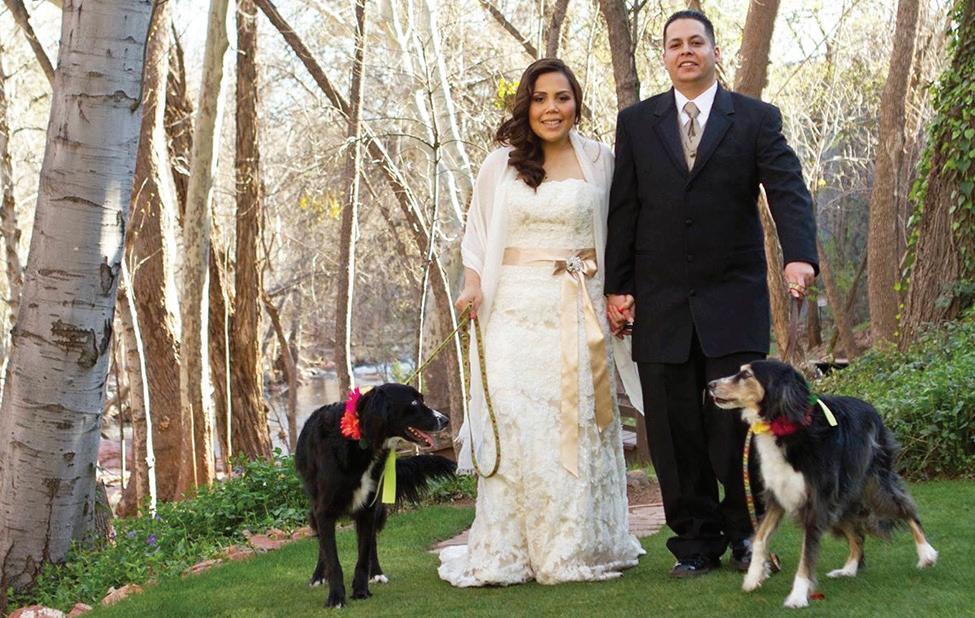
9 minute read
COMMUNITY
For more community news visit gilbertsunnews.com
GilbertSunNews.com | @GilbertSunNews /GilbertSunNews
Gilbert teen addresses global health experts
BY KEN SAIN
GSN Staff Writer
Arizona College Prep senior Sohani Sandhu has a plan to end the COVID-19 pandemic: learn the lessons from one of her least favorite subjects – history.
The Gilbert resident over summer presented her plan as part of the Global Health Leaders Conference at Johns Hopkins University, one of the top medical schools in the world. Her topic was what lessons learned from the smallpox pandemic can be applied to ending the COVID threat.
“This was one off the deadliest pandemics that ever happened, but it was still stopped,” Sohani said. “It took a long time, but it was still stopped because people came together and stopped it.”
The Centers for Disease Control says there is evidence smallpox existed as far back as when Egypt was making mummies some 3,000 years ago, killing three of every 10 people who got the disease.
A vaccine was developed in 1796 but it wasn’t until 1959 that the World Health Organization began a plan to eradicate smallpox.
With mass vaccinations across the world, they succeeded. A declaration went out in May 1980 that the disease was no more. It did, however, kill between 300 and 500 million people in the 20th century alone.
Sohani said the lesson from that pandemic is that vaccines work. The W.H.O. made it a priority to vaccinate everyone who came into contact with an infected person.
Doing the same for COVID-19 will not be as easy. First, when you got smallpox you knew it because the symptoms were obvious, Sohani said.
That’s not the case for COVID and many people who are asymptomatic are unknowingly spreading the virus.
“The huge reason smallpox was eradicated was the vaccine,” Sohani said.
If COVID is to join smallpox on the list of eradicated diseases, Sohani said everyone must get vaccinated.
Sohani found out about the Global Health Leaders Conference at her school and applied to participate. She said she wasn’t sure if she would be chosen because it was open to high school students around the world and there were only 300 spots.
Once she was chosen, she applied to be one of the few chosen to give a presentation. There were fewer than 50 presentations planned. Getting to that point took finding something to love about something she hated.
Sohani said she was assigned a mandatory history project in the sixth grade.
“I hate history,” she said.
Her teacher suggested she focus on
Gilbert resident Sohani Sandu, a senior at ASrizona College Prep, participated in a global health conference. (Special to GSN)
see PANDEMIC page 11
Gilbert woman seeks help battling cancer
BY ALEX GALLAGHER
GSN Staff Writer
It is hard for Menith Sonhthipanya-Gonzales to remember what her life was like before her diagnosis of simultaneous primary tumors.
The Gilbert woman’s life was a constant whirlwind of traveling around the country as a medical vendor and evaluating hospital equipment.
It was around two years ago when Sonhthipanya-Gonzalez began to feel fatigued and lethargic. So she went to a doctor and the initial diagnosis was fatigue from insufficient vitamin D.
She did not think anything further and kept going on with her life.
During this time, she had begun trying to have a child with her husband of 11-years, Erik.
The two were not having any luck and as a result, Sonhthipanya-Gonzalez decided to try in-vitro fertilization over the summer.
During the process, Sonhthipanya-Gonzalez had to adhere to a specific routine if she wanted to become pregnant. And it was not long into the process that she realized something was wrong.
“When you’re doing IVF, it’s critical that everything is timed and that every injection is 12 hours apart perfectly,” she said. “For 10 days, I injected myself with medication and one day I had the most excruciating pain. It was then that I knew something was not right.”
Doctors told her that she was just

Help sought for wreaths on veterans’ graves
GSN NEWS STAFF
The tradition started in 1992 in Maine when a family that owned a tree farm had a surplus of Christmas wreaths and donated the extras to the Arlington National Cemetery to put on its graves.
And over the years, that thoughtful act blossomed into a nationwide movement in which anyone can honor deceased veterans by contributing to local organizations that place wreaths on their graves.
This year, the Exchange Club of Chandler and its counterpart in Ahwatukee are working with Valley of the Sun Mortuary and Cemetery in Chandler for the sixth annual Chandler Wreaths Across America Day event on Dec. 18.
Over time, the event has drawn other organizations, including Chandler Elks Lodge #2429 and the Ahwatukee-based Exchange Club of Phoenix.
Their goal is to raise enough money to place wreaths on approximately 2,800 veterans’ graves at Valley of the Sun Cemetery.
Last year, approximately 1,800 wreaths were sponsored and organizer Mark Whitaker said, “We will need help from the community to achieve the goal of sponsoring 2,800 wreaths.”
According to the U.S. Department of Defense, the Maine family that started this tradition got an eager reception to their proposal.
“Several volunteers stepped up to help, including veterans from American Legion and Veterans of Foreign Wars posts and a truck company owner who transported the wreaths to Arlington, Virginia, where a small ceremony was held at the cemetery’s Tomb of the Unknown Soldier,” according to department.
This remained a small yearly tradition for nearly 15 years until a photo taken at the 2005 ceremony went viral.
“Almost immediately, thousands of people wanted to know how to help or how they could begin a similar tradition in their states,” the Defense Department said.
By 2008, it had become a tradition at dozens of cemeteries across the country and has continued to grow, with more than 2.2 million graves across the country now decorated with a wreath at more than 2,100 cemeteries.
Chandler’s annual event consists of laying out the wreaths and a memorial ceremony. Volunteers will begin gathering around 8 a.m. for light refreshments and the laying of the wreaths will begin at 9 a.m., Whitaker said.
“Each wreath symbolizes the commitment to remember and honor our nation’s veterans and teach our children about freedom and the sacrifice required to maintain our freedom,” Whitaker said.
There will be an educational activity for children to help them learn about veterans.
“As wreaths are laid, we ask that the volunteers respectfully remember the veteran by saying the veteran’s name aloud,” Whitaker said.
The formal ceremony will start at 10 a.m. and will be streamed on Facebook Live on the Valley of the Sun Cemetery, Chandler Elks, and the Exchange Clubs of Chandler and Phoenix Facebook pages.
Valley of the Sun Mortuary and Cemetery has been serving Chandler and the East Valley since 1963.
Between now and Nov. 30, people can sponsor a wreath for $15. They can also sponsor a family pack of four wreaths for $60. Small business sponsorships of $150 support 10 wreaths.
To make a donation: reathsacrossamerica.org/AZ0084P.
PANDEMIC from page 10 things she likes. At that point, it was medicine because her mother was a nurse. She also enjoyed science since she had started a biology class.
Her teacher suggested looking at past pandemics. And that’s when she first started researching small pox and ended up doing to her mandatory history project on the disease.
Her mother, Harwinder Sohani, said her daughter is always working.
“My son is in medical also,” she said. “But she’s the one interested in medical. I feel so proud.”
Part of what keeps her busy is Sohani and some of her friends at school are about to launch their own medical device.
As part of a 9th grade project, they invented the hydro-hat, which she calls a heat stroke prevention device.
It caught the eye of Arizona State University and the Healthy Urban Environment program, which Sohani said offered them a $50,000 grant to make it. They also received a $2,500 grant from Intel for the device.
She said they have a patent pending and have formed their own company. They are currently testing a prototype now.
That background led her to create a research club at Arizona College Prep.
“If you ask anyone at my school, ‘what does Sohani do?’ they’re like, ‘science.’ That’s pretty much it.”
CANCER from page 10
experiencing abdominal pain from the medication she was injecting. They recommended that she try a warm bath or using a cold compress on the area in pain.
Sonhthipanya-Gonzalez did that but the pain would not go away.
She went to the emergency room and later to Scottsdale Medical Imaging – which was where Sonhthipanya-Gonzalez got the news that would change her life.
She learned that she had a tumor on her spine and another in her uterine lining.
“I felt numb,” Sonhthipanya-Gonzalez said. “My life changed within less than a day. This went from being nothing to being catastrophic.”
She then began to coordinate with doctors what was next.
They concluded she needed surgery to remove the tumors. She received her first surgery in June to remove the tumor in her back and her husband started a GoFundMe page to help with the looming medical bills that her insurance could not cover.
“I did the surgery with the completion of it, meaning that they removed all of the affected cells,” Sonhthipanya-Gonzalez said.
Despite a successful procedure, she still has a long road ahead to recovery – including another surgery.
“I have to have imaging repeated every six months, bloodwork done every three months and there is always that fear of it returning in the back of my mind,” Sonhthipanya-Gonzalez said.
She is also receiving massage and intravenous therapy as part of treatment.
However, the most expensive part of her recovery is trying to get into Mayo Clinic’s Pain Rehabilitation Center, a three-week program that helps people that are going through chronic pain navigate life and figure out a course of action.
This is a big bill that her insurance will not cover. The GoFundMe has currently raised over $12,000 of its $75,000 goal.
“When we started (the GoFundMe), I didn’t have a goal in mind and I didn’t think it would garner any attention,” Sonhthipanya-Gonzalez said. “It is very touching and I am beyond grateful that people care that much to donate, especially because most of the people who have donated don’t know me directly.”
Sonhthipanya-Gonzalez has felt touched by every dollar donated to her battle, but she still is adjusting to her new normal.
“My norm now is waking up, seeing what doctors’ appointments I need, taking my vitamins or supplements, doing my pain rehabilitation, and figuring out what procedures or imaging studies are needed next,” she said.




